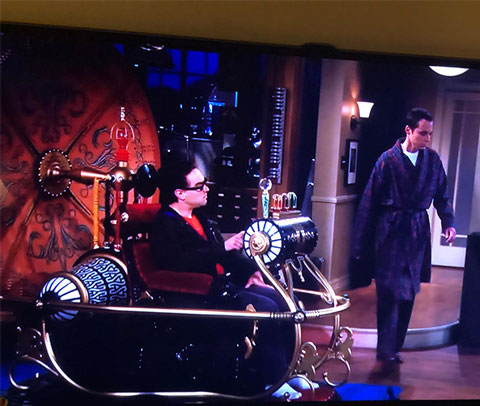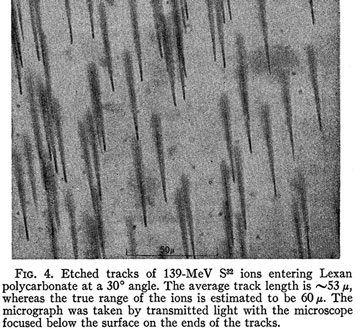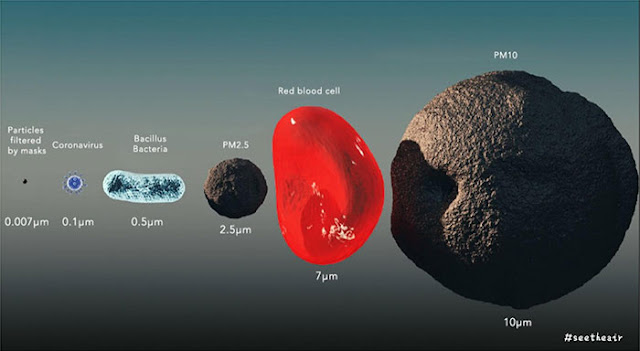Well here we are again, stuck in our burrows, but in the meantime while we wait for freedom, we can report on ongoing activity at Boca Chica and an interesting discussion of using small samples of minerals from deep in the Earth as solid state particle detectors for neutrinos and perhaps dark energy. You might also get a hint or two about how this social isolation is beginning to affect me.
So progress is still ongoing at Boca Chica and we hope to see the Starship test hop in the next week or two. It seems like just one Raptor engine is required for the test hop, and here we see one of the Raptors being moved about. Hmm, I guess United Rentals is another one of those unsung heroes as work continues!
 |
| Raptor engine being transported on rented telehandler (Source @BocaChicaGal) |
We really have appreciated @BocaChicaGal's outside the fence photos of ongoing activity and here we get an actual photo from @elonmusk showing the underside of the Starship SN4 and just a single Raptor engine in place. Elon tweeted that this is plenty more room for the needed engines when Starship actually travels to orbit and beyond. Go Elon!
 |
| Single Raptor engine, with room for more, beneath Starship SN4 (Source: @elonmusk) |
By the way, it seems that Elon is, like the rest of us, getting impatient about getting back to work here in California. I have a lot of sympathy for this line of argument. Initially we didn't have enough information to form a rational judgement of the risks, but it seems we now are seeing much wider range of possible responses to the virus from around the world. Why have other countries, such as Sweden, have elected different approaches and don't see the damage to the economic and social dreams and relationships to the people, while also seeming to limit the number of deaths? We know that older, more susceptible individuals bear the most risk and they should be isolated and protected, but why are the rest of us quarantined? We need more data on herd immunity and how many individuals can be spreading the virus without themselves suffering any symptoms. If you have any flu like symptoms, stay home! Joblessness and social isolation is causing a lot of damage. Isn't there a more rational, not reckless, position than just continuing with the lockdown? My skeptical nature is to ask that when the doctors are in charge of how long the lockdown lasts, they know they will be held accountable for the number of deaths, but they also recognize that they probably won't be judged for the trillions of dollars of lost wages and dreams and millions of people pushed back into poverty. It is not an either or proposition; both the number of deaths and the amount of economic damage need to be on the table while we protect the most vulnerable. For me, I am willing to personally take on a bit more risk, if it can be better understood, with some combination of social distancing and maybe masks, in order to keep the waiters, bartenders and other service and manufacturing folks back at work. We want also a better understanding how much we might unintentionally contribute to infecting someone else ourselves. The goal being to keep the number of deaths down while at the same time getting the economy and peoples dreams back at work. What say you?
 |
| Elon speaks up for freedom (Source: Some Facebook post attributed to Elon Musk) |
In the meantime, just like we had to do when we toured the facilities in Boca Chica, we can only peer through the fence at the vacant beach and wait for the day when we get to lay about in the sun again. It was nice to see all that empty sand and waves and imagine that day coming sooner rather than later.
 |
| All we can do is peer through the fence at the empty Laguna beach (Source: Palmia Observatory) |
While we continue to do zoom the world with other conferences and meetings and even a happy hour or two, we wonder what real 3-D people are like. Our contact with the outside world is made easier by our local friends at Amazon, but even they seem to be invisible and disappear before we can open the door. Hmm, well, I guess as long as the boxes keep coming! Thank you Amazon!
 |
| Social isolation -- Even the Amazon delivery escapes before we can open the door (Source: Palmia Observatory) |
We even dream of the time when it is all behind us. This episode from the Big Bang Theory and the time machine hit home. Hmm, now if only the closed time like curves from general relativity could somehow be implemented we would be out of lockdown!
 |
| Social isolation -- Dreaming of a time machine (Source: The Big Bang Theory) |
Ok, ok, it is time to actually get back to work and look at some interesting discussions about using solid state detectors to detect neutrinos and maybe even dark matter. We know about the large vessels of pure water of or dry cleaning fluid or even the Antarctic ice that make up many of the instruments used to search for neutrinos or dark matter.
An article in Quanta Magazine is one place where Katherine Freese discussed how solid state detectors, like small mineral crystals could be used as dark matter particle detectors. Another article talked about how minerals from deep within the Earth could also be used as solid state neutrino detectors which could also tell the history of neutrino flux through the Earth.
I remember meeting Professor Freese in an elevator at some astronomy conference, back when they were actually held in person, and I was talking to her about her work and I asked if she was going to use her iconic boa during her upcoming presentation. She said something like that the boa was not strong enough for the tough audience she was expecting. Hmm, I day dreamed, as we got off the elevator in the exhibit hall, she could tie me up with her light weight boa and teach me physics anytime!
 |
| Professor Freese discusses solid state dark matter detectors (Source: quantamagazine.org) |
The concept of using these small mineral samples, which would be collected from deep underground so that the effects of other known sources of high energy particles, such as muons and cosmic rays, would be eliminated by the overburden. These samples can be found in some of the deep bore holes that have already been drilled into the Earth. We would also get the added benefit to tracking the flux of neutrinos or maybe even dark matter fluxes over time by identifying the age of the rocks.
So, there is a lot of particle physics of dark matter and neutrinos and how they interact with matter, but for this short blog let's look at some aspects of the nature of the tracks themselves as they show up in minerals and crystals. This first photo from a Scientific American article shows an example of particle tracks in a slice of mica.
 |
| Nuclear tracks in thin sheet of mica (Source: Scientific American) |
This image shows the tracks produced in Lexan from a beam of ionized sulfur atoms. What would we expect about the direction of the particle in this case, i.e. is the entry at the pointy end of the track or at the more rounded end? Hmm, I might guess that the entry is at the pointy end and then as the incoming particle loses energy it slows down and then has more time to cause more damage just as it dissipates entirely? What say you?
 |
| Average track length in Lexan for high energy ions (Source: R. Fleischer, et al, Physical Review, 2 March 1964) |
How are tracks created by a high energy particle passing through a mineral? Is it kind of like a bullet that just passes through and causes a lot of damage? Yes, it seems something like that in that the high energy particle ionizes the bonds that hold the mineral together and the breaking of bonds and subsequent strain leaves a permanent record of the particle passing through.
 |
| Ionization induced stress deforms crystal and makes tracks (Source: A. M. Bhagwat, ISRP(K)-TD-2, 1993) |
So, we see how an ionizing particle can cause the track and it records something about the direction and energy of the incoming particle. But what result would a neutrino have on this mineral, if after traveling through the solar system and then through most of the Earth and then just by chance striking and interacting with same atom in the mineral? Well, we can say, I suppose, that the reaction will produce a whole lot of charged particles, which themselves are going to damage the mineral structure. the example using Lexan under those experimental conditions resulted in tracks of about 53 microns in length. It is interesting to compare this 53 micron length to the size of other dust and biological particles. Note how small the corona virus is. Hopefully most of the airborne virus will come out as small water droplets from infected people. The size of fog particles is not shown but it is on the large size of about 10-15 microns.
 |
| Typical particle sizes (Source: www.smartairfilters.com) |
It seems we might have been trying too hard to understand how the general relativistic description of the big bang and early hot plasma results in our universe. Maybe we could have just picked up a can of primordial soup and enjoyed ourselves! Thanks for that, David!
 |
| Taking a break and having a laugh on Facebook (Source: David Naiditch, Facebook post) |
Finally, let's finish up this blog post with a little quiz where you have to decide what is going on in this image from a recent film. I don't remember what the name of the movie, it might have been the 1997 movie, "The Jackal." I don't recall the plot, but when I saw this image on some remote Facebook post, I imagined two scenarios. So, let me know what you imagine this scene is about and here are my two:
- Socially isolated astronomer comes out of his burrow and dedicates his time to bring back not just a photo of the UFO, but the UFO itself.
- Socially isolated astronomer comes out of his burrow and swears he is going to get the next errant automobile whose lights ruin his hour long exposure.
What say you?
 | |
|
Until next time, here from our burrow, stay safe, but it's time to recover more of our freedom,
Resident Astronomer George
Be sure to check out over 400 other blog posts on similar topics
If you are interested in things astronomical or in astrophysics and cosmology
Check out this blog at www.palmiaobservatory.com

No comments:
Post a Comment